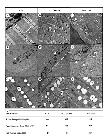Abstract
Purpose:
To evaluate the effects of duodenal-jejunal bypass (DJB) on the diaphragm muscle of obese rats fed on a western diet (WD) .
Methods:
Eighteen male Wistar rats were fed a standard rodent chow diet (CTL group) or WD ad libitum. After 10 weeks, WD rats were submitted to sham (WD SHAM) or duodenal-jejunal bypass (WD DJB). The structure, ultrastructure, collagen content and the morphometry of the neuromuscular junctions (NMJs) were analyzed two months after surgery.
Results:
WD SHAM rats displayed an increase in body weight, the Lee index and retroperitoneal and peri-epididymal fat pads compared to the CTL group. DJB did not alter these parameters. The muscle fiber structure and NMJs were similar in the WD SHAM and CTL groups. However, the WD SHAM group showed alterations in the fiber ultrastructure, such as loosely arranged myofibrils and Z line disorganization. In addition, WD SHAM animals presented a considerable amount of lipid droplets and a reduction in the percentage of collagen compared to the CTL group. DJB did not affect the structure or ultrastructure of the muscle fibers or the NMJs in the diaphragm of the WD DJB animals.
Conclusion:
Duodenal-jejunal bypass did not improve the alterations observed in the diaphragm of western diet obese-rats.
Key words:
Duodenal-jejunal Bypass; Diaphragm; Neuromuscular Junction; Obesity; Muscle Fibers; Rats

 Thumbnail
Thumbnail
 Thumbnail
Thumbnail
 Thumbnail
Thumbnail
 Thumbnail
Thumbnail
 Thumbnail
Thumbnail




